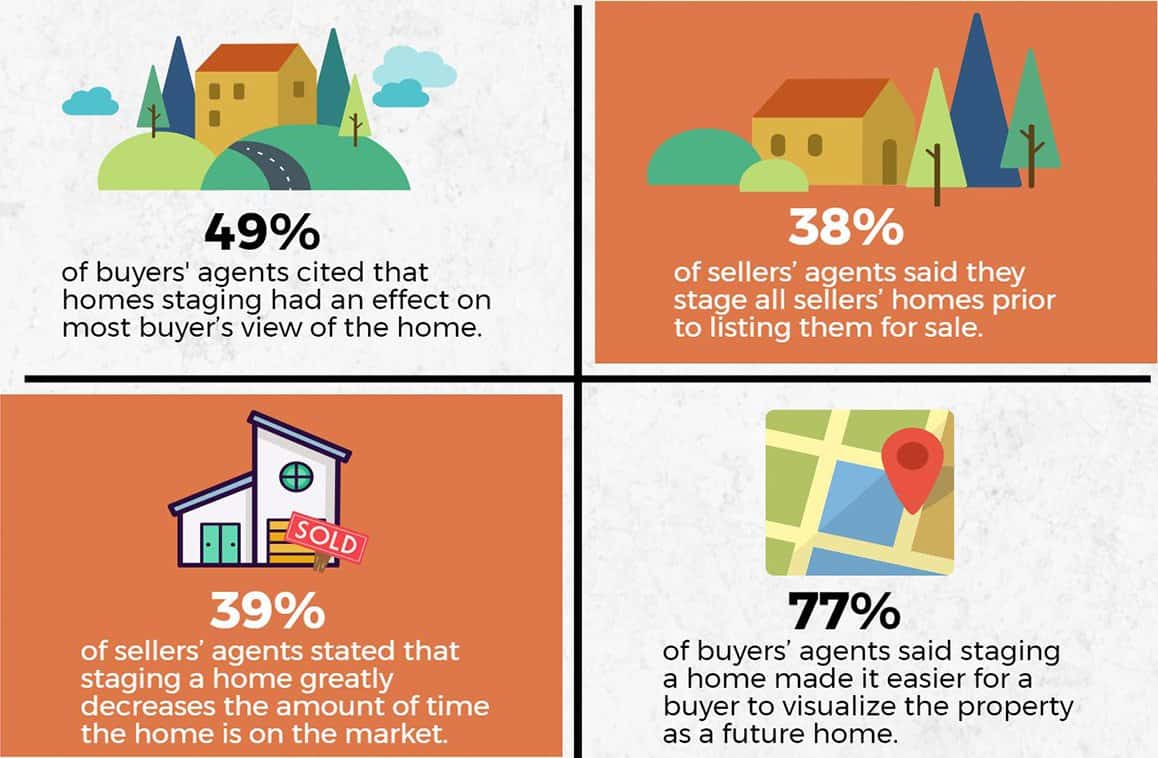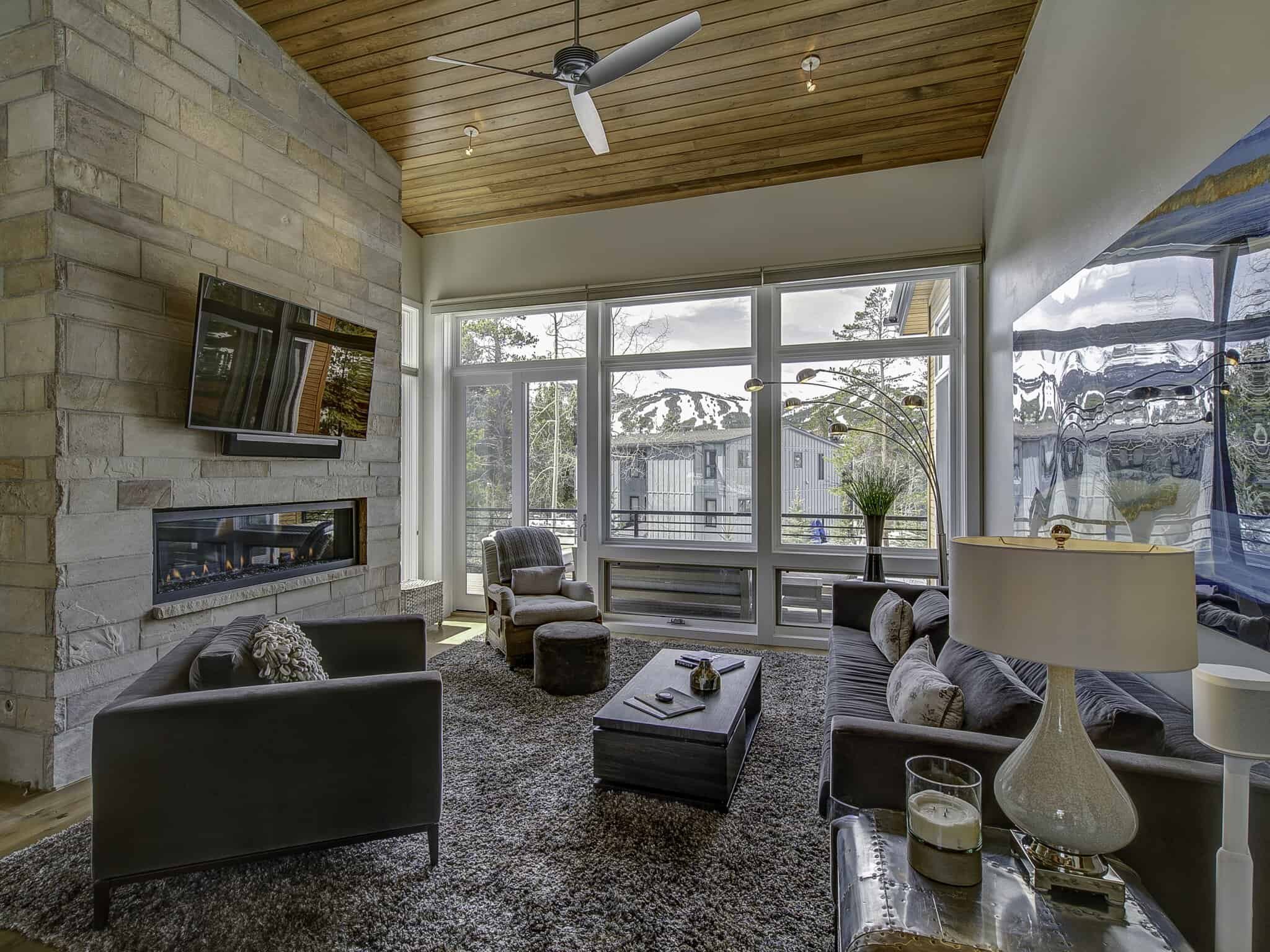When it comes to selling your home, naturally you’ll want to ensure that you sell it within a reasonable timeframe –and for the best price possible. Staging a home for a quick sale can be a quick effort with very large returns.
While the market is the main factor that will dictate the price and the timeframe in which you’re able to sell the property, there’s something else that you can do to help give your home a significant competitive edge.
Introducing: staging –something that you’ve undoubtedly heard about or seen in design magazines –and a strategy that many sellers today are employing as an additional set of steps to selling a house.
The truth is prospective buyers will form an opinion on your house within seconds of entering your home, so it’s vital to ensure that you make a good first impression when selling.
This is where home staging comes in.
Staging: What is It?
The real estate market is always fluctuating; sometimes favoring sellers, sometimes buyers –but no matter what the market, there’s always competition for buyers.
The showing of a home should impress the potential buyer right away, and ideally, should create the vision of a comfortable, efficient, enhanced lifestyle that will come along with living in that home. If a buyer feels that a home will enhance their life, it will become very attractive –something that home staging can help to facilitate.
In short? Home staging is the process of casting a home in the most attractive light in order to facilitate a quick sale, for the best possible price.
A stager will use decorative flair and knowledge of potential buyers’ needs and desires to increase the likelihood of a positive impact on those who view the home. This involves a keen knowledge of different demographics, as well as an eye for style and a flair for making homes look good.
Staging a Home for Quick Sale: How Does It Work?
In countless cases, staging has proven to be effective –whether a home is occupied or vacant.
As Colorado Springs Home Stager Megan Stackhouse observed, “It’s important to understand that buyers are not only comparing your home to others they have seen but to what they see on home improvement programs like they see on HGTV.”
“Younger homebuyers are more in tune with design trends because they see them everywhere online,” Stackhouse says.
In other words, there is a lot of competition out there for buyers and staging will give a better chance for a quick, top-dollar sale.
The National Association of REALTORS® 2017 Profile of Home Staging shows staging to be quite effective, with 77% of buyers’ agents stating that staging a home made it easier for a buyer to visualize the property as a future home. Additionally, 40% of buyers were more willing to walk through a home they saw online. Importantly, this study also found that 38% of the time, buyers’ agents identified staging as having a positive impact on the home value if the home was decorated to the buyer’s taste.

Generally, a stager will work to ensure that the home has a light and open look. This often involves removing heavy, outdated curtains –and opting for something lighter or even leaving the windows bare if the view outside is good. It also involves incorporating furniture and colors that’ll help to showcase the home in the best possible light.
Pieces should be neutral and modern, and shouldn’t be too big, or else they’ll risk overwhelming the space. A good stager will also bring in decor items –new furniture, updated lighting fixtures, lamps, rugs, mirrors, sculptures, candlesticks, and plants to accentuate the home’s best features, and help a potential buyer to envision themselves living in the space –while at the same time taking care not to overwhelm the space with too many things. In the end, good staging is a balancing act –and one that an experienced stager will be familiar with.
But staging isn’t just used to spruce up lived-in homes; it’s often used when it comes to new-build homes as well. Builders know that staging helps to show prospective buyers how the home can meet and exceed their needs, goals, and desires –and recognize the value of this investment.
In order to get the most out of staging, it’s important for the seller to be able to separate from a personal attachment to the home. This is something that’s often tremendously difficult to do, but it’s a vital part of transitioning from a homeowner to a home seller –and absolutely essential for getting the home into sell-ready condition. It’s vital for the homeowner to regard the property, not as their home, but as a commodity to be sold quickly and for top dollar. This mindset will allow the seller to prioritize the things that need to be done to bring about a favorable sale.
How Much Does House Staging Cost?
The only real disadvantages to staging are the time and money spent on staging costs and the appraisal. But when you consider that the average price reduction for homes in the MLS is approximately $5,000 to $10,000 –substantially more than the cost of staging, the cost-benefit analysis quickly begins to tilt in staging’s favor.
Also, consider the cost of time. How many house payments would be saved if staging resulted in a quick sale? Additionally, in many cases, staging helps the seller to command top-dollar for their home, which means that they can come out ahead in terms of the speed of the sale and the sale price. Home sellers may be reluctant to stage in such a market where homes are selling in days and not months, but the data plainly shows that staged homes sell faster and for more money. In fact, in very hot seller’s markets and in very popular price ranges, staging may even lead to a bidding war among potential buyers. Of course, if you prefer to avoid a bidding war and any resulting appraisal issues, it’s a good idea to run those concerns by your REALTOR® to see what they recommend.
The observation that staging can lead to a higher sale value, again, is supported by the National Association of REALTORS® 2017 Profile of Home Staging. When staging a home, 29% of sellers’ agents reported an increase of 1-5% of the dollar value offered by buyers compared to similar homes. Additionally, 21% of survey respondents stated that staging a home increased the dollar value of the home between 6-10%. In no case did the respondents report that staging a home had a negative impact on the home’s dollar value.
The cost of staging must certainly be considered, but estimating the cost is challenging without seeing the property. There are many factors that influence the price such as the size and condition of the home and whether or not it’s vacant or occupied.
Staging an empty house requires bringing in furniture and accessories which results in furniture rental costs and mover fees. However, occupied homes bring other considerations as well. If the homeowner’s furniture and accessories can be used the price will be reduced, but generally, some items will need to be removed and placed into storage. The cost of removing personal items, moving furniture, cleaning and making needed repairs will also impact the cost; although the homeowner may be willing to do some of the work themselves, therefore lowering the costs.
For sellers who may be wondering how to stage a house for sale while living in it, it’s important to note that it is certainly possible –but it can be a bit more challenging. In some cases, the homeowner’s furniture and accessories may be able to be used, but more often than not new pieces may need to be brought in. At the very least, new slipcovers may need to be purchased to spruce up outdated furnishings, and some fresh, new accessories brought in. Personal accessories, souvenirs, and mementos –such as photos, children’s artwork, and similar items should all be removed, and there should be a focus on implementing neutral decor throughout. Remember, the goal is for the potential buyers to envision themselves living there –and that’s something that’s hard to do when there are tokens of the previous owners everywhere. Clutter should be kept to a minimum, baskets can be brought in to house spare items, while extra pieces should be put into storage. Beds should be updated with fresh new duvets, and every attempt should be made at keeping the home in a clean and tidy state. Of course, the extent of work and the number of purchases that are required to bring a seller-occupied home up to scratch will significantly impact the staging price.
Comparing vacant versus occupied prices from recent similar transactions gives a good cost comparison:
- A vacant 3,000-square-foot home had five rooms staged (the main rooms plus the master bedroom and bath) for a cost of $1,600 plus $195 per month furniture rental.
- An occupied home, also 3,000 square feet and five rooms staged, cost $625 to stage plus furniture rental of $115 per month.
Of course, the number of rooms that are staged will also have a big impact on cost. Usually, a stager will do the living room, family room, kitchen, master bedroom, master bathroom, and the den or study. Generally, the main level of a home, the master suite, and any large recreational areas are staged as well. Depending on the home’s price point, additional bedrooms may be staged as well, especially if they have attached baths. This is usually done for luxury properties.
At times special features of a property must be included when staging as well. For example, a very large wraparound deck with a gorgeous view may not have its area included in the square footage of the home, but it certainly should be staged to present the property in its most favorable light. The deck may need some new furniture, which would increase the cost of staging a bit.
Because of the unique nature of each individual property, it simply isn’t possible to provide a firm formula for pricing. The best we can do is share numbers based on our experience. Generally speaking, we’ve found the range to be between $500 and $5,000 –or, in some cases, even more depending on the size of the home and the number of rooms staged. The average home will cost $1,200 to $2,000.
Staging costs can be paid in several ways. The home seller can pay, or the REALTOR® may pay as part of their service. Sometimes the REALTOR® pays and is then compensated at closing. The National Association of REALTORS® 2017 Profile of Home Staging states that 25% of the time the costs of staging a home were typically paid by the seller before the home is listed, while 21% of the time the seller’s agent personally offered to stage the home, and 14% of the time the seller’s agents offered a home staging service.
Normally stagers will accept a 50% deposit before work begins with the balance due at the completion of staging. Payment can usually be made by check or debit/credit card. The monthly furniture rental can be paid for by check or by automatic payment via debit/credit card as well. Automatic billing is a popular method for monthly charges. If the seller wishes, they’ll usually have the option to purchase any of the staging items or furniture.
Staging should always be done before listing photos are taken. In today’s world photos are more important than ever –and in many ways are the new first-showing. Photos taken after staging greatly increase the likelihood a home will actually get shown. At this time it’s important for the seller to remember that they are not the homeowner but the seller and must keep the home in its best sellable condition. The stager can help with ideas or routines for maintaining the work that they have done.
Alternatives to full staging include what’s known as soft staging and virtual staging. Each of these has their own sets of pros and cons. Let’s look at them now.
Soft staging
Soft staging is normally done on properties that are vacant. As the name suggests, this type of staging is less involved than full staging and consists of simply adding plants, candles, artwork, and other decorations order to give a home a warmer, less barren feel. When done well, it certainly can help but it’s important to keep in mind that it’s not a substitute for full professional staging. For home staging tips for sellers, be sure to check out this helpful article: Home staging ideas to help you sell your home.
It’s important to note that some items that are lumped under the category of soft staging are actually simply basic tasks that should always be performed prior to staging itself. This generally includes cleaning and ensuring that the home is kept free from clutter. According to the National Association of Realtors’ home staging report, the most common items that agents recommended were decluttering the home (93%), entire home cleaning (89%), carpet cleaning (81%), and removing pets during showings (80%).
Virtual staging
Virtual staging is a technique that’s used primarily on vacant properties –and is one idea for staging an empty house. The virtual stager uses photo manipulation software –like Photoshop, to virtually place furniture and decorations in a room. When done by a talented virtual stager, the pictures can make the room look attractive, but more often than not the pictures end up looking artificial. Additionally, there’s another downside of using virtual staging as well –the risk of disappointing a prospective buyer. A potential buyer who was impressed favorably by the virtually staged photos that they saw online, will almost certainly be very disappointed when entering the room and finding it empty.
What to Look for in a Stager
Ok, so you’re thinking of choosing a stager. Naturally, you’ll want to ensure that the one you opt to go with is the right choice –someone with a skill to transform your home into a sell-ready property.
For REALTORS®, recommending a stager also involves several considerations. A REALTOR® bringing a stager to the transaction must ensure that they are someone who can work well with the home sellers. Tact and empathy will go a long way to avoid hurt feelings or resentment.
If you’re a seller who will be hiring the stager yourself, you should find someone you can work with comfortably, someone who doesn’t intimidate you –and who’s able to make recommendations tactfully.
In either case, a stager must be able to show impressive before and after photos of their work. These images should clearly demonstrate a stager’s expertise and skill, showing you what they’re capable of, and giving you a good idea about what you can expect when working with them.
You’ll want to choose a stager that is appropriate for your situation. This means that if your home is a median-priced property, you’ll want to avoid choosing someone who specializes in multimillion-dollar properties unless they are really good at median price listings as well. Choose a stager that will accentuate the positive aspects of the home you are listing –not just someone who works primarily with homes that are in a different price bracket than yours.
Your stager should also own their own furniture and accessories –or should be able to source them easily, and should provide the delivery service and movers as well. If your listing ends up being long-term, the stager should also be prepared to update the seasonal elements to keep the property looking current.
Finally, a look at the technicalities. A stager should have a business license with the state that you’re in, carry liability insurance, and should have a certification from a formal staging organization. These organizations include the International Association of Home Staging Professionals, the American Society of Home Stagers and Redesigners, the Real Estate Staging Association, and the Home Staging and ReDesign Association.
In the end, enthusiasm is the final differentiator and is a good indication of someone who loves their job, and who will be a joy to work with. Be sure to look for a stager who’s excited about your project, and who enjoys working with the decor style that the house dictates.
In conclusion, there is little doubt that staging can help a home to sell more quickly and for more money. The only reasons to not consider staging are the time required, cost of staging, or appraisal issues. At the end of the day, your success with staging is largely contingent on the stager that you choose –so make your decision carefully, looking for someone with both skill, and experience working with homes that are similar to yours. In most cases, your REALTOR® will work with stagers and may even be able to recommend one to you, so be sure to have a discussion with your agent to see if they can recommend someone that they trust.
Additional Staging Resources:
- Should I Stage My Home Or Leave it Empty-Bill Gassett
- Professional Home Staging Tips to get Top Dollar for Your Home-Kevin Vitali
- 10 Easy Home Staging Tips-Sharon Paxson
- Should I Sell My Home Empty Or Staged?-Kyle Hiscock
For more information on home sales in Colorado Springs, be sure to get in touch with Springs Homes today. Our agents will work hard to help your home sell as quickly as possible –and for a competitive price.

